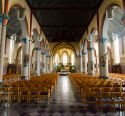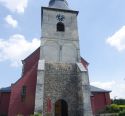In the footsteps of the priest
Less sporty? Or is it raining cats and dogs? We have connected the most interesting sights with a route adapted to the car (in Dutch).
This car tour is part of four routes designed by the network of Open Churches, "Rulers and Saints, Religious Heritage around Alden Biesen". 28 churches and heritage buildings in Limburg open their doors to share their history, their treasures and their unique atmosphere with you. These routes will take you back to the time of popular devotion, pilgrimages and hermits. You will meet the first Christians and the noble lords who shaped these beautiful buildings. You will learn more about the land commanders and monastic superiors who exerted their influence far beyond the walls of their domain.
Download our pdf flyer (in Dutch)
Continue on PC Download PDF Continue on mobile
-
Great Commandery of Alden Biesen
Alden Biesen was a country commandery of the Teutonic Order. In 1220 they received the land from Alden Biesen. This complex was at the head of a long belt of commanderies that stretched from Bekkevoort all the way to Bonn. These were accountable to the land commander, who led the complex Alden Biesen (...)
-
Church of the Great Commandery – Alden Biesen
A legend lies at the origin of the foundation of a chapel in Biesen. According to the story, at the beginning of the 13th century there were fierce disputes in the region. Our Lady appeared and asked for a chapel to be built for her, on which peace would return (...)
-
Sint-Martinuskerk – Martenslinde
This church was founded by the abbey of Munsterbilzen. The Tenth Law was partly in the hands of the abbey and partly in those of the commandery of Alden Biesen. The Gothic choir (ca. 1400) of the old church has been preserved (...)
-
Sint-Mauritiuskerk – Bilzen
The neo-Gothic Sint-Mauritius church has a colourful painted interior. The pentagonal choir dates back to the Gothic period. The tombstone of Bocholtz's family was discovered under the high altar and was given a new place under the tower at the back of the church (...)
-
Abdij van Munsterbilzen
Legend has it that Saint Landrada founded a church dedicated to Our Lady here around 670. Around this church a women's monastery was built, which was destroyed by the Norsemen around 880 (...)
-
Onze-Lieve-Vrouw Hemelvaartkerk – Munsterbilzen
Thanks to its rich abbey history, Munsterbilzen has had several churches. However, after the French Revolution and the invasion of the French armies, they were completely destroyed, with the exception of the 16th century tower.
-
Visitors centre De Landschapsruiter – Bilzen
In 2006, during work on the N730 near the church, some rare tree trunk graves were discovered: hollow trees in which the deceased were buried. They date from the early Middle Ages (...)
-
Sint-Ursulakerk – Eigenbilzen
This colourful, neo-gothic church was built at the beginning of the 20th century. The tower is much older. It is built in marlstone. The bright interior of the church has recently been completely restored and contains some showpieces such as the oak pulpit whose shell is carried by a woman with a cross and a chalice in her hand (...)
-
Sint-Kwintensfietskluis – Hees
The old church of Hees had been in serious decline since the 1970s. Only the 14th century tower and part of the aisle have been preserved. After a long period of vacancy, the church was given a new function as a bicycle locker. You can spend the night here as a cyclist in one of the two camping huts. On the ground floor there is a meeting area for the neighbourhood (...)
-
Bertilia source - Rosmeer
At the Bertilia source, Rosmerta, the Celtic goddess of fertility and abundance, was worshipped in the past. This ritual was given a Christian touch in the seventh century, after which the source became a well-known place of pilgrimage (...)
-
Sint-Pieterskerk – Rosmeer
Rosmeer is an old parish, but how far back her history goes is unknown. The earliest written document about the parish is a charter of Henry II, bishop of Liège, from 1148. The tower of the church probably dates from the 12th century. It probably first served as a defence tower (...)
-
Sint-Lambertuskerk – Grote-Spouwen
In 1220, the abbey of Hocht (Lanaken) was granted the right of patronage over the church. Over the centuries, the building was regularly repaired by the abbeys of the abbey, which sometimes had the year of the repairs carried out as a reminder. However, during the French Revolution, the abbey lost its rights (...)
-
Sint-Rochuskapel – Grote-Spouwen
Recently restored chapel flanked by an old beech dedicated to St. Roch. The year above the door is misleading because the chapel dates from the 19th century. The year may refer to an earlier chapel.
-
Sint-Hubertuskerk – Membruggen
Neo-Romanesque church dedicated to the patron saint of hunting, St. Hubert. The square tower is built in marlstone. The lower layers date back to 1757. In 1726, the former church collapsed: two parishioners were buried under the rubble.
-
Sint-Jansbond – Membruggen
By the 1850s there were no fewer than six breweries in Membruggen with a population of about 500 people. With 27 inns on 80 houses, Membruggen gained a bad reputation as a beer and especially a jenever village (...)
-
Genoelselderen chateau
Around 1200, the early medieval domain of Heldren was divided into two distinct territories, namely 's Herenelderen and Genoels-Elderen. Godenoel I (+1305), the presumed builder of the castle, was buried together with his wife Marula (+1300) in the church of Genoels-Elderen. Until 1718, for eleven generations, the family of Elderen was in charge of this seigniory (...)
-
Sint-Martinuskerk – Genoelselderen
The Sint-Martinus church was built by order of Prince Bishop Jean-Louis d'Elderen (1688-1694) and was in keeping with the Meuse style of that time. This church was preceded at least by a Romanesque building (...)
-
Renesse castle – 's Herenelderen
The lords of 's Herenelderen, the family of Hamal, lived in this moated castle from the 13th century until 1501. Afterwards, the castle passed into the hands of the de Renesse family. Several members of both families are buried in the Sint-Stefanus church. The castle farm extends along the Sint-Stefanusstraat and has two corner towers (...)
-
Kerk Sint-Stephanus – 's-Herenelderen
St. Stephen's Church was founded in 1261 by the lords of Elderen, the inhabitants of the nearby castle. The present Gothic church dates from the 15th century and is entirely built in marlstone. On the main altar is a 16th century Antwerp altarpiece depicting the life of Christ and the Old Testament (...)
-
Hermitage of Vrijhern – St-Huibrechts-Hern
In the 17th century, the first hermit, Geert van Elst, settled here on the outskirts of the village. It is possible that he also built the nearby St. Anne's Chapel (...)
-
Sint-Stefanuskerk – Hoeselt
Strikingly colourful, classicistic church from the 18th century with a much older tower. Inside, the most valuable works of art are collected in a treasure room. The early gothic baptismal font is one of the oldest and most remarkable pieces in the church.





